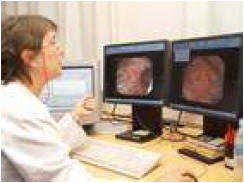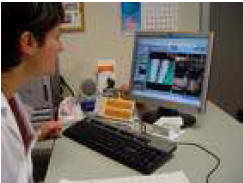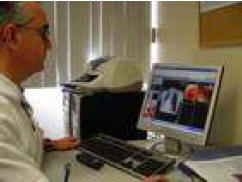Multimedia PACS networks healthcare services on the Balearic Islands
8 April 2008
All public hospitals and about 80 primary health centres
in the Spanish
region Islas Baleares are building the foundation of a health
service network which is unique in Europe for its scope and depth of
integration.
Using a master patient index, Balearic doctors can access patient data and medical results anytime. Via a web-viewer solution they are able to retrieve digital data, films and radiological images wherever they are located.
The centralised multimedia archive solution in the Son Llatzer Hospital at Palma de Mallorca offers radiology images, extracts of endoscopy treatments, dermatology patient images or data out of ophthalmology exams to all clinicians.
This is all based on GE’s Centricity PACS with an advanced infrastructure and DICOM capabilities. Effective processes not only cut down on costs but also can reduce a patient’s stay in the hospital.
The success story of the Balearic Islands ehealth project began in 2001 with the building of the Son Llatzer Hospital and the plan for a digital operation throughout the site.
To lead innovative ideas to success requires more than just state-of-the-art products. With Luis Alegre Latorre, Director Asistencial IB-Salut and Miguel Cabrer, eHealth Advisor, the project found the support of two visionaries who were able to recognize trends and implement them successfully. Within five years they developed the Son Llatzer RIS/PACS project into a regional ehealth solution with referrer’s portal and a central multimedia archive.
Luis Alegre Latorre comments: “The success of this project demonstrates that you can streamline processes and save costs in healthcare with the help of modern IT solutions.” The realisation of this vision is a result of good cooperation between all parties involved and a professional project implementation by GE Healthcare.
From PACS to ehealth
Following the implementation of the radiology solution, the chief medical officers and the hospital management of Son Llatzer recognized the enormous advantages of an enterprise-wide digital image and data distribution in radiology. "Nobody needs to wait a long time anymore for radiological data. Via intranet, all images are available on demand, immediately, and no matter where you are in the building. The wish for a similar solution in dermatology came up fast,” said Miguel Cabrer.
Just at that moment the national healthcare policy in Spain changed. In 2002, the central administration of public hospitals was delegated to the regions by the national government.
The Islas Baleares region — as did all other
regions in Spain — founded IB-Salut, their own healthcare
enterprise, which directly reports to
the regional Ministry of Health and Consumer Service. All regional
health services received a budget to ease the start into the new
autonomy.
For Luis Alegre Latorre, this meant the expansion of the Centricity RIS/PACS into a regional ehealth project. Based on the positive experiences with this solution in Son Llatzer hospital he was convinced it would be successful.
“In the meantime, the University Hospital Son Dureta, the Manacor
Hospital as well as the Can Misses Clinics in Ibiza and one hospital
in Menorca were endowed with a standardised Centricity RIS/PACS
solution. Moreover, a total of about 80 primary health centres (PHCs)
are connected to the network,” says Luis Alegre Latorre, who is
excited
to share the success of this investment. The remaining hospitals are
about to be equipped.
One central databank for all patient images
The total healthcare network on the islands achieved a depth of integration, which is unique across Europe. Usually ambulatory exams in Spain are provided in so-called primary health centres, where various medical specialists take care of the population.
Via an online portal, doctors of PHCs have direct access to the electronic documents of their patients. The Baleares already use a master patient index, which allows physicians in any PHC to retrieve electronic records of any registered patient. In reality this means that an inhabitant of Menorca who unfortunately has an accident, for example, in Mallorca or Ibiza, easily releases all personal, relevant medical data in all PHCs and clinics at the push of a button.
 |
|
Dr Carmen Martinez:"With
our modern worklist management any |
In the radiology department of Dr Carmen Martinez, Cap d'Unitat de Radiologia, conventional films and images never existed. In Son Llatzer, the radiologists work on integrated RIS/PACS workstations. The moment they dictate the medical results, the speech-recognition system assures that the report is finished soon after the treatment, saving time and money.
Minutes after a radiological exam, images and subsequent diagnosis are available throughout the total network of the community. Exam requests also come directly via the web, no matter if it is for in- or out-patients transferred from a PHC.
A little more than one million people live on the Balearic Islands and profit enormously from the integrated network of their healthcare system. Clinics and PHCs have already started projects to further improve patient care.
During a stroke every second counts. The University Hospital San Dureta is the only medical centre of the region with a special department for stroke patients. Thanks to the centralised image archive, the ‘stroke unit’ specialist can already prepare an exam for the suffering person while he/she is still in transit to San Dureta.
Teledermatology
The Dermatology Institute in Son Llatzer established a teledermatology project with a selected primary health centre. For example, a primary health centre's dermatologist photographs an eczema, converts the data into a DICOM (digital imaging and communication in medicine) compatible format, sends it digitally to the PACS and finally transfers the image to dermatologist Dr Rosa Teberner Ferrer at the Son Llatzer Hospital.
 |
|
Retrieving images within a second makes the work of dermatologist Dr Rosa Taberner Ferrer much more efficient. |
“From this image we can immediately decide if the patient needs to visit us or can be further examined by his private practitioner,” said Rosa Teberner Ferrer, from her first and very positive results of the study. The main advantage she derives from this network is the digital image archive. Previously, when slides were produced, she rarely had the possibility to compare images of older skin diseases during an exam.
Today the dermatologist is able to not only compare different images with a few clicks on her screen, but is also able to consult a huge dermatology images archive. This tremendously improves her daily work routine.
Telemedicine reduces costs
 |
|
Dr Carlos Dolz reviewing endoscopy images |
Her colleague Dr Carlos Dolz from the Endoscopy Department also greatly appreciates the advantages of the digital image archive. From any of the 550 computers in the hospital, he can easily retrieve digital images and videos of endoscopy sequences via GE Healthcare’s Web-Viewer. Moreover, he can easily compare endoscopy with radiology images. This increases the safety of diagnoses. Dr Carlos Dolz commented, “Thanks to the multi-media PACS, images and medical records are available ubiquitously. This is the decisive advantage of a digital workflow.”
Intelligent image data management beyond radiology and cardiology is still a future wish in many other European countries. In Mallorca, Menorca and Ibiza this is already reality. Doctors archive the different images of dermatology or endoscopy findings by means of a so called ‘DICOMizer’ in a DICOM format, a standard protocol for medical applications. The Medical Images Organiser (MIO) by C2C helps to allocate the specific patient information to the appropriate image.
The digital workflow in Son Llatzer drives efficiency and profitability. JM Campuzano Casasayas, Director Gerente says, “Modern IT solutions are a key factor for the success of a healthcare enterprise. IT improves the whole cycle of care a patient goes through during his stay in the hospital and thus significantly helps to save costs and time.”
The investment truly pays off, according to the hospital manager. This is especially the case when all clinical work steps are following the digital workflow as in Son Llazer. In other European hospitals ward physicians still show radiological films to their patients. Thanks to Web-Viewer, in Son Llatzer, a doctor is able to bring his small laptop directly to the patient’s bedside where he explains the medical findings.
Luis Alegre Latorre said: "With the regional solution on the Balearic Islands, IB-Salut demonstrates that ehealth not only functions but pays off.”